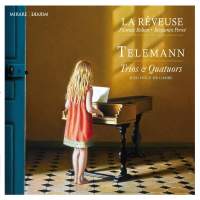Texte paru dans: / Appeared in: |
|
| Evaluation: "Well recommended." | |
|
Reviewer: Bertil
van Boer
Ah me, more Telemann! And part
of the vast number of chamber works, at that, here focusing upon the viola
da gamba, an instrument that he, like many others, began to explore even as
it began its inevitable decline later in the century. Here we have six
works, essentially trio sonatas or quartets (the disc is entitled actually
Trios and Quartets), in which this is the main instrument. These works are
drawn from the early Trios from 1718, as well as the 1727 Esercizii Musici
and 1730 Quadri, but end with the grand chaconne from the “Parisian”
Quartets of 1738, a group of works wherein Telemann began his transition
from the Baroque to the galant style. It is an eclectic gathering, but one
that gives an overview in a short series of how Telemann progressed along
the stylistic scale during the first half of the 18th century. The French
group La Rêveuse, consisting of gambists Florence Bolton and Emily Audouin,
violinist Stéphan Dudermel, flautist Serge Saitta, and a continuo group led
by Benjamin Perrot on the theorbo and Carsten Lohff on the harpsichord, has
gathered an eclectic program that demonstrates, yet again, the versatility
of Telemann as a composer of small ensemble compositions. Three of the works are trio sonatas, but what is unusual are the combinations that are by no means absolutely generic, as was often the case during this period. The A-Minor Sonata (TWV 42:a7) is for the usual duo soloists, in this case a traverso and a solo gamba. The tone is somewhat more old-fashioned at the beginning, but the finale has a rapid Polish tinge to it that gives it a folk-like underpinning. The G-Minor Sonata (TWV 42:g1) features the duo of a violin and gamba, and their close suspensive harmonies at the opening, with the violin rising above the texture with a mezza di voce, make it rather more modern sounding. This sets up the following movement, with all instruments making a series of rolling motives that spin about frantically. This in turn devolves into an aria, with a lyrical line that evokes grace. The final Trio (TWV 42:G6) features an obbligato harpsichord, which merges well with the fluid gamba line. The second movement is a rather austere fugue, but this resolves to a long and languid fantasia movement that almost seems as if it suspends time. A finale with a perpetual motion theme rounds off this unusual piece.
The quartets (here meaning
three melody instruments and continuo) are also three in number, although
the last work on the disc is only the excerpt of a chaconne movement from
the so-called “Parisian” Quartets of 1738. Here, the French style is evident
in the graceful and stately motion of the bass, above which the instruments
never really get up to speed. It is almost a tombeau in the French style.
The G-Minor Quartet (TWV 43:g1), however, comes from Telemann’s late Baroque
style of 1730, the so-called Quadri. The opening suspensions contain some
rather close harmonies that are unusually chromatic and modern sounding,
though the second movement revolves around the more traditional Fortspinnung
in all instruments. The G-Major Quartet (TWV 43:G12) has the intermediate
instrumentation of a pair of gambas, giving depth to the sonority. My
favorite movement of this quartet is the finale, where the instruments leap
and bound, and then join in rising suspensions. As for the performances, it is rare to hear such absolutely exquisite ensemble playing. All of La Réveuse’s members move as if they were one, with clear intonation, precise ornamentation and rapid passage work, and suitably flexible tempos that outline Telemann’s music extremely well. This disc is an example of detail and precision that should serve as a model. Well recommended. | |
|
|
|
|
|
|
|
Cliquez l'un ou l'autre
bouton pour découvrir bien d'autres critiques de CD |
|



